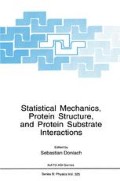Abstract
In order to obtain a simple characterization of the molten globule state of proteins, we re-examine a simple model for the formation and stability of secondary structures in proteins. We consider chains on a cubic lattice; each monomer can be considered to reperesent a helical turn, and we assign a Boltzmann weight exp(ε H /T) when two monomers are aligned, and 1 when they make a turn. Here, ε H is positive and represents the energy gain due to hydrogen bonds (H-bonds). In addition, we include an attractive nearest neighbour monomer—monomer interaction to represent the hydrophobic effect which drives the collapse of the chains. In the thermodynamic limit ( and in the mean-field approximation), the system undergoes two transitions: first, a second order collapse transition at high temperature, from random coil to globular structures, similar to the usual theta point of polymers. Then, at lower temperature, the system undergoes a first order freezing transition, from a high temperature phase where the helix-like secondary structures are present but mobile in the system, to a frozen phase where secondary structures invade the whole globule, and make their turns only on the outside surface. We have checked these results by extensive Monte Carlo simulations on finite chains, and have indeed observed the theta point at higher temperature, and the freezing transition at lower temperature. The structure factor in this frozen phase exhibits more structure than in the non-frozen phase, and the number of co—linear bonds is maximized. Above the freezing transition, the number of H-bonds drops sharply, but the system still exhibits significant secondary structure, and we observe a slight increase of the radius of gyration. The collapsed phase above the freezing point thus provides a simplified representation of the molten globule phase of real proteins.
Access this chapter
Tax calculation will be finalised at checkout
Purchases are for personal use only
Preview
Unable to display preview. Download preview PDF.
References
Kolinski A; Skolnick J; Yaris R. “ Monte Carlo simulations on an equilibrium globular protein folding model.” Proc. Natl. Acad. Sci. USA 1986 Oct, 83 (19):7267–71.
T.E. Creighton, Proteins, W.H. Freeman, New York, (1984).
O.B. Ptitsyn, “Protein Folding: Hypotheses and Experiments”, J. Prot. Chem. 6, 273–293 (1987).
T. Garel and H. Orland, “Guided replication of random chains: a new Monte Carlo method”, J. Phys. A23, L621–624 (1990).
B. Velikson, T. Garel, J.C. Niel, H. Orland and J.C. Smith, “Conformational distribution of heptaalanine: analysis using a new Monte Carlo chain growth method”, J. Comp. Chem. 13, 1216–1233 (1992).
J. Bascle, S. Doniach, T. Garel and H. Orland revised manuscript in preparation.
P.J. Flory, Principles of Polymer Chemistry, Cornell University Press, Ithaca, N.Y. (1971).
P.G. de Gennes, Scaling Concepts in Polymer Physics, Cornell University Press, Ithaca, N.Y. (1979).
J. des Cloizeaux and G. Jannink, Polymers Solution, their Modelling and Structure, Clarendon Press, (1990).
J. Bascle, T. Garel and H. Orland, “Mean-field theory of polymer melting”, J. Phys. A 25, L1323–1329 (1992).
J. Bascle, T. Garel and H. Orland, “Formation and stability of secondary structures in globular proteins”, J. Physique (France) II, 3, 245–253 (1993).
J. Bascle, T. Garel and H. Orland, “Some physical approaches to protein folding”, J. Physique (France) I, 3, 259–275 (1993).
Ptitsyn OB; Pain RH; Semisotnov GV; Zerovnik E; Razgulyaev O.I. “Evidence for a molten globule state as a general intermediate in protein folding.” Febs Letters, 1990 Mar 12, 262 (1):20–4.
V. Dagget and M. Levitt, “ A model of the molten globule from molecular dynamics simulations”, Proc. Natl. Acad. Sci. USA 89, 5142–5146 (1992).
Shakhnovich EI; Finkelstein AV. “Theory of cooperative transitions in protein molecules. I. Why denaturation of globular protein is a first-order phase transition.” Biopolymers, 1989 Oct, 28(10):1667–80.
Finkelstein AV; Shakhnovich EI. “Theory of cooperative transitions in protein molecules. II. Phase diagram for a protein molecule in solution.” Biopolymers, 1989 Oct, 28(10):1681–94.
Author information
Authors and Affiliations
Editor information
Editors and Affiliations
Rights and permissions
Copyright information
© 1994 Springer Science+Business Media New York
About this chapter
Cite this chapter
Bascle, J., Doniach, S., Garel, T., Orland, H. (1994). Statistical Mechanics of Secondary Structures in Proteins: Characterization of a molten globule—like state. In: Doniach, S. (eds) Statistical Mechanics, Protein Structure, and Protein Substrate Interactions. NATO ASI Series, vol 325. Springer, Boston, MA. https://doi.org/10.1007/978-1-4899-1349-4_10
Download citation
DOI: https://doi.org/10.1007/978-1-4899-1349-4_10
Publisher Name: Springer, Boston, MA
Print ISBN: 978-1-4899-1351-7
Online ISBN: 978-1-4899-1349-4
eBook Packages: Springer Book Archive

